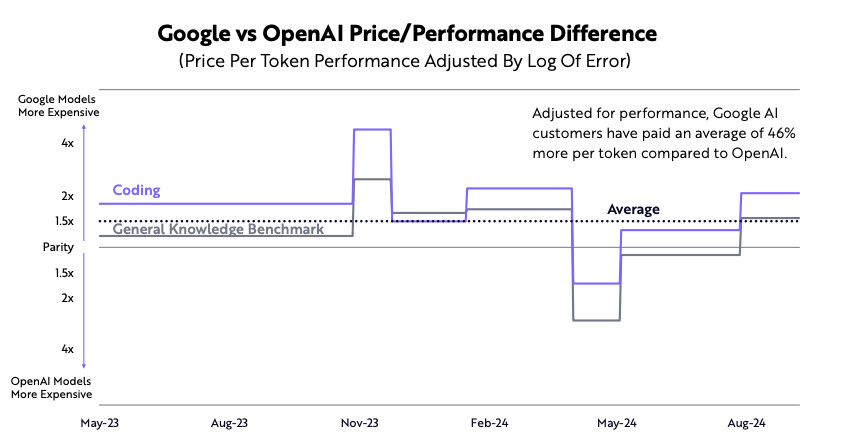Can Industry Titans Like Apple and Google Keep Up with Agile Startups in the Disruptive Tech Race?


In Brief
The AI revolution is characterized by unprecedented cost reduction, with AI models’ performance costs decreasing half every four months, compared to Moore’s Law in semiconductors.

A new white paper released by Cathie Wood’s investment firm, ARK Invest, sheds light on the intricate dynamics as prominent business figures navigate the AI landscape.
The Transformation in AI Costs
An unparalleled rate of cost reduction is at the core of the AI revolution. The white paper’s author and chief futurist at ARK Invest, Brett Winton, emphasizes that the cost of running AI models with comparable performance has been cut in half every four months. This is the greatest cost-decrease curve in the history of technology, and it is predicted to continue for the next ten years.
Winton compares this to Moore’s Law in the semiconductor business, where prices normally drop by half every 18 to 24 months, to put things into perspective. The ramifications are obvious: the rate of the AI revolution is four to six times quicker than that of the semiconductor revolution, which has been the engine of technological growth for decades.
Established IT firms face a double-edged sword as a result of this fast cost drop. On the one hand, it offers a chance to make use of progressively potent AI capabilities at declining costs. However, it also makes it easier for startups and smaller rivals to enter the market, which might challenge the big businesses’ hegemony.
The Disruptive Technologies’ Qualities
According to ARK Invest, disruptive technology platforms have three key characteristics: they penetrate new or underserved industries, have significant cost drops, and have business models that take time to monetize and may not seem financially appealing at first.
These qualities foster an atmosphere in which more agile, smaller businesses might challenge the industry giants’ dominance—even when those companies are aware of the potential of the technology and are making efforts to use it for their own financial advantage.
Since AI has each of these characteristics, it is the ultimate disruptive technology. Its prospective applications span a wide range of areas, many of which are currently underserved by current technologies, and its fast cost drops are already apparent. Furthermore, a lot of AI-driven business models follow the trend of disruptive technology by placing more emphasis on user acquisition and data collecting than on quick monetization.
The Big Tech Approach to AI
Both Apple and Google have taken a cautious approach to integrating AI in light of this disruptive potential. According to Winton, established tech businesses frequently use this tactic, letting startups “de-risk” innovative ideas before using them widely.
This method is shown by Google’s handling of massive language models. The business waited to make its sophisticated language model available to the public until after OpenAI had been available for more than three years. Even yet, Google’s performance was not as good as OpenAI’s, and users had to pay more than 40% more for Google’s most sophisticated model than for OpenAI’s most effective one.

Photo: ARK Invest
Despite its reputation for rigorous product development, Apple has not yet released a major language model. The business will likely launch its first cutting-edge AI-powered goods in the fall of 2024, far later than many of its rivals.
There are benefits to this methodical approach. As Winton points out, transporting goods that exhibit erratic behavior may be rather unsettling for those who look after a well-built reputation. The foundation of both Google and Apple’s success has been the provision of dependable, user-friendly goods and services. AI’s capacity to yield unexpected or unwanted results poses a serious threat to users’ faith in the company and its brand.
The Opportunity for New Entrants
Due to AI’s disruptive nature and quickly dropping prices, there are many potential for new players to challenge the dominance of well-established tech giants. Smaller businesses and startups may be better equipped to take full use of AI’s promise since they are less constrained by legacy systems and can move rapidly.
This is not just an AI dynamic. Throughout technology’s history, spurts of fast development have frequently resulted in the ascent of new market leaders at the expense of more established firms. New dominating companies emerged with each shift from mainframe computers to personal computers and then to mobile devices.
There might be a similar trend to the AI transformation. Businesses that can quickly experiment, iterate, and adjust to the changing AI landscape might benefit greatly. As a result, the tech sector may become more vibrant and competitive, with new companies emerging to challenge the established powerhouses like Apple and Google.
Managing Innovation and Risk in Balance
The difficulty for Apple and Google is finding the ideal mix between risk management and innovation. These businesses have made billions of users worldwide happy by providing polished, dependable goods and services. Their careful approach to integrating AI is indicative of a thorough comprehension of the possible hazards involved with using unforeseen technology on a large scale.
On the other hand, being overly cautious could lead to lost chances. Since AI is developing so quickly, major changes in the technological environment might occur within months. Businesses who take a long time to adjust run the danger of having to play catch-up in a market that has advanced.
Furthermore, because of the nature of AI development, improvements frequently come via widespread implementation and real-world input. Apple and Google could be reducing their capacity to obtain the information and understanding required to enhance and develop their AI systems if they postpone the release of AI-driven features and products.
Disclaimer
In line with the Trust Project guidelines, please note that the information provided on this page is not intended to be and should not be interpreted as legal, tax, investment, financial, or any other form of advice. It is important to only invest what you can afford to lose and to seek independent financial advice if you have any doubts. For further information, we suggest referring to the terms and conditions as well as the help and support pages provided by the issuer or advertiser. MetaversePost is committed to accurate, unbiased reporting, but market conditions are subject to change without notice.
About The Author
Victoria is a writer on a variety of technology topics including Web3.0, AI and cryptocurrencies. Her extensive experience allows her to write insightful articles for the wider audience.
More articles

Victoria is a writer on a variety of technology topics including Web3.0, AI and cryptocurrencies. Her extensive experience allows her to write insightful articles for the wider audience.

















































